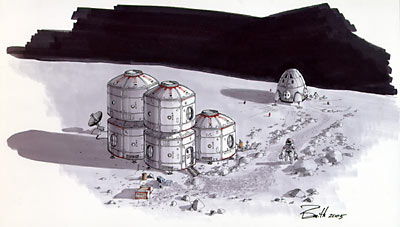Capitalize the Moonby Sam Dinkin
|
Moon or moon?A quick Google search of grammar guides shows that the jury is out about whether the Moon should be capitalized. When a moon is used as a generic, everyone agrees it should not be capitalized. When the Moon is used as place in combination with other cool places in the Solar System as in, “Mars, Phobos and the Moon are the top destinations for colonization,” most agree that Moon should be capitalized. Earth, Moon and Sun even when used as proper nouns tend not to be capitalized as often without accompanying the Name Planets. An astronomy discussion of the phases of a moon is OK, but the phases of the Moon should be capitalized. “Lunar” ought to be capitalized, too, as long as we continue to capitalize “French”. It is essential to promote the Moon and not leave it undercapitalized. Making the Moon a place like Europe gives it six times as much gravitas. The Moon is a place to go. The Moon is nearby. The Moon is significant. The Moon is not just another moon. |
The Moon itself is a thing of great natural beauty. It is definitely one of the premier geological wonders of cislunar space. The Moon is excellent for solitude and quiet. The far side of the Moon will be a nice place to get away from it all until there is a Lunar comsat network. There ought to be fine radio and visual astronomy back there. And where there are observatories, there is a trickle of tourists. Maybe the new thing for weddings and parties on Earth will be crushing a Lunar vacuum bulb made of Lunar glass.
The Moon is a fun place to experiment with low gravity in a frictionless environment. Imagine stretching out the largest trampoline in the solar system across one of the craters. Trampolines can also be useful for commerce. If a huge hoop is suspended vertically over a deep crater, spaceships or cargo containers can fly through, be caught and decelerated. The net would need to reel out fast and far. At 10g deceleration, it will only take 25 seconds to slow down from 2.4 km/sec escape velocity, which would take you 30 kilometers from the hoop. At 27 kilometers away, there should be a bar or wire that the net can hang from or else the ship will fall down to the bottom of the crater. The deepest crater on the Moon is Newton at just over 3000 meters deep. The hoop could also be used for accelerating cargo and space ships back into space. A daredevil willing to black out can Moon dive from L-1 or be shot there, but would need a pretty good g-suit to stand 10g for 25 seconds.
A hoop with strong fibers attached is just a bunch of slingshots superimposed. Maybe a more elegant solution to the same problem would be grabbing a cord with a tail hook and slowing down on a super-long runway. If you can build the runway 3000 kilometers long you can apply the brakes gently at 0.1g and skip the tail hook. Alternatively, the runway can tunnel into a crater and loop around. The centripetal force would be big, but then the brakes would work better. Does anyone want to skateboard from orbit?
| At Tranquility Base, everything is pretty much the way Neil and Buzz left it in 1969. That might make an excellent tourist attraction. |
Speaking of tunnels, if a journey to the center of the Earth is not yet operational, perhaps a developer can drill down 1000 kilometers or so to get two-thirds of the way to the center of the Moon. Since the lava isn’t flowing down there and gravity is less than 0.01g, maybe it would be possible to cool and harden a passage all the way to the core if it exists. In the mean time, that core tap could generate a good deal of electricity whether or not the attraction proves popular for tourists. A one-thousand-kilometer shaft would be a stretch with current technology—even at Lunar gravity there would be fifteen thousand tons of rock overhead at 30 kilometers which would put us at the limit of Terrestrial mining.
A 30-kilometer long Lunar shaft would make a nice spot for a mass driver or a good spot for the hoop catcher. Site it pointing along the Lunar orbit to go onward or at the Earth to go there. That would be a nice reversal on Jules Verne’s gun on Earth shooting space ships at the Moon and his Journey to the Center of the Earth.
